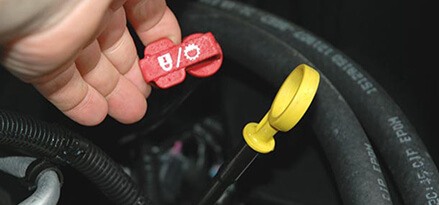Mixing transmission fluid with oil disrupts the formulated chemistry, leading to a negative impact on wear protection, detergency, and other essential functions. Adding transmission fluid to the oil can reduce the engine’s lubrication ability and viscosity, hindering its overall performance.
Impact On Wear Protection And Detergency
Transmission Fluid’s Impact On Formulated Chemistry
When you put transmission fluid in the oil of your engine, it disrupts the carefully formulated chemistry of the engine oil. Engine oil is designed to provide optimal wear protection and detergency, but adding a foreign substance like transmission fluid can negatively impact these crucial functions.
Negative Effects On Wear Protection And Detergency
One of the main negative effects of adding transmission fluid to the engine oil is the reduction in wear protection. Engine oil is specifically formulated to create a thin protective layer between moving parts, reducing friction and preventing excessive wear and tear. However, when transmission fluid is mixed in, it can alter the viscosity of the oil, hampering its ability to flow smoothly and provide sufficient protection.
Furthermore, transmission fluid contains detergents and additives that are specifically designed for cleaning and maintaining the transmission system. When added to the engine oil, these detergents may disrupt the delicate balance of detergency in the oil.
Engine oil detergents are responsible for removing harmful deposits and contaminants from the engine, ensuring optimal performance. The introduction of transmission fluid can potentially interfere with this crucial function, leading to a decrease in engine cleanliness and efficiency.
In conclusion, putting transmission fluid in the oil compromises the wear protection and detergency capabilities of the engine oil.
It alters the formulated chemistry, reducing its ability to provide sufficient protection for the engine components and maintain cleanliness. It is essential to use the right fluids in your car to ensure optimal lubrication and performance.

Credit: www.mobil.com
Cleaning Properties Of Transmission Fluid In The Engine
When it comes to the topic of putting transmission fluid in the oil, it’s important to understand the potential effects it can have on your engine. One aspect worth discussing is the cleaning properties of transmission fluid when introduced into the engine. While it may seem like an unusual practice, some individuals believe that adding small amounts of transmission fluid to the oil can have positive effects, particularly in terms of valve cleaning and reducing carbon and sludge deposits.
The Potential Benefits Of Transmission Fluid In Cleaning Valves
Valves play a crucial role in the combustion process of an engine, and over time, they can become dirty and prone to sticking. Fortunately, transmission fluid has cleaning properties that can help address these issues. When introduced into the oil, transmission fluid can act as a detergent, breaking down carbon and sludge deposits that may have built up on the valves. This can help improve valve performance and maintain optimal engine functionality.
Reducing Noisy Valve Rain And Carbon/sludge Deposits
Noisy valve rain can be a cause of concern for many engine owners, as it can indicate valve-related problems. However, the addition of small amounts of transmission fluid to the oil can potentially help reduce valve noise. The cleaning properties of transmission fluid can help dissolve carbon and sludge deposits that may be causing the valves to stick or create unwanted noise. By minimizing these deposits, the valves are likely to operate more smoothly, resulting in quieter engine performance.

It’s important to note that while small amounts of transmission fluid in the oil can offer potential benefits in terms of valve cleaning, it is essential to exercise caution. Adding excessive amounts of transmission fluid may disrupt the formulated chemistry of the oil, negatively impacting wear protection and detergency.
It is crucial to adhere to recommended guidelines and consult with a professional if you are unsure about the appropriate amount to add.
In conclusion, while the practice of putting transmission fluid in the oil may not be widely recommended, it is worth exploring its potential benefits in terms of valve cleaning and reducing carbon and sludge deposits. Used in moderation and following proper guidelines, small amounts of transmission fluid may help improve valve performance and reduce noisy valve rain.
t is important to exercise caution and consult with a professional if unsure about the appropriate amount to add. By understanding the potential effects, engine owners can make informed decisions about their maintenance routine and ensure the longevity and optimal performance of their engines.
Effects On Engine Viscosity And Lubrication
Increase In Engine Oil’s Viscosity Due To Transmission Fluid
When transmission fluid is mistakenly added to the engine oil, it can lead to an increase in the oil’s viscosity. Now, why is this a problem? Well, viscosity refers to the oil’s thickness or resistance to flow. Ideally, the engine oil should have a specific viscosity designed to provide optimal lubrication to the engine’s moving parts. However, transmission fluid has a different viscosity compared to engine oil. It is typically thicker and more viscous.
Hampering The Engine Oil’s Ability To Flow
The difference in viscosity between transmission fluid and engine oil can hamper the engine oil’s ability to flow smoothly throughout the engine. This is because the engine oil pump may struggle to pump the thicker mixture, causing inadequate lubrication to crucial engine components. Without proper lubrication, the engine parts may experience increased friction and wear, which can lead to overheating and potential long-term damage to the engine.
Impaired Lubrication And Potential Long-term Damage To The Engine
Furthermore, mixing transmission fluid with engine oil can result in impaired lubrication. Engine oil is specifically formulated to provide the necessary lubrication and protection to the engine’s internal components. However, the addition of transmission fluid can disrupt the oil’s formulated chemistry, diminishing its lubricating properties.
As a result, the engine may be at risk of increased wear, decreased efficiency, and potential long-term damage.
In conclusion, the inadvertent addition of transmission fluid to the engine oil can have detrimental effects on engine viscosity, lubrication, and overall engine health. It is crucial to ensure the correct fluids are used in their designated places to maintain the optimal functioning and longevity of the engine.
Precautions And Solutions
Accidentally putting transmission fluid in the oil can be a cause for concern, but it doesn’t necessarily mean all hope is lost. There are precautions you can take and solutions to remedy the situation. Here’s what you need to know:
What To Do If You Accidentally Put Transmission Fluid In The Oil
If you find yourself in the unfortunate situation of mixing transmission fluid with your engine oil, there are a couple of steps you should take:
- First and foremost, do not start your engine. Running your engine with the mixture of transmission fluid and oil can lead to severe damage.
- Next, drain the contaminated oil as soon as possible. This will help prevent further damage and ensure the proper functioning of your engine.
- Replace the oil filter. The oil filter may need to be replaced as it could have absorbed some of the transmission fluid.
- After draining the contaminated oil and replacing the oil filter, add the appropriate amount of clean motor oil according to your vehicle’s specifications.
- Once you have completed these steps, you should be able to safely start your engine without any further issues.
Recommendations For Seeking Professional Help Or Advice From Mechanics

If you are unsure about how to handle the situation or if you don’t feel confident in performing the necessary steps on your own, it is highly recommended to seek professional help or advice from qualified mechanics.
They have the expertise and experience to correctly assess the situation and provide appropriate guidance. Ignoring the issue or attempting to fix it without proper knowledge can result in costly repairs and further damage to your vehicle.
Potential Solutions To Dilute Or Remove The Mixture Of Transmission Fluid And Oil
In some cases, the mixture of transmission fluid and oil may be diluted or removed to minimize the potential harm it can cause. Here are a few potential solutions:
- Oil Flush: Consider performing an oil flush to completely remove the contaminated oil from your system. An oil flush involves running a specialized cleaning solution through the engine, which helps remove any impurities or foreign substances.
- Multiple Oil Changes: Another option is to perform multiple oil changes in quick succession. This can help dilute the mixture and gradually remove the transmission fluid from the oil.
- Consult with a Professional: If you are uncertain about the best approach for your specific situation, it is advisable to consult with a professional mechanic. They can provide tailored advice and recommend the most suitable solution based on the extent of contamination and the condition of your engine.
Remember, prevention is always better than cure. It is crucial to double-check the fluids and use the right ones for their intended purposes to avoid any potential mishaps. Regularly checking your vehicle’s fluids and following the manufacturer’s recommendations for maintenance can help prevent costly errors like mixing transmission fluid with the engine oil.
Frequently Asked Questions Of What Happens If You Put Transmission Fluid In The Oil
Can You Drive Car With Transmission Fluid In Oil?
Putting transmission fluid in the oil of a car can negatively impact wear protection and detergency. It disrupts the formulated chemistry of the oil, which reduces its ability to provide proper lubrication to the engine. It is not recommended to drive a car with transmission fluid in the oil.
What Happens If You Put Gear Oil In The Engine?
Putting gear oil in the engine can cause various issues. Gear oil is thicker than engine oil and cannot withstand the higher temperatures in the engine. This can lead to poor lubrication, increased wear on engine parts, and potential damage to the engine.
It is important to drain the gear oil and replace it with the correct engine oil to avoid any further complications.
Do They Add Transmission Fluid During Oil Change?
No, transmission fluid is not typically added during an oil change. The auto shop will generally only top off fluids like windshield fluid and power steering fluid as a courtesy. Adding transmission fluid to the oil can negatively impact wear protection and detergency.
What Happens If I Put Transmission Fluid In My Coolant?
When transmission fluid is put into the coolant, it can cause damage to the cooling system. The transmission fluid disrupts the formulated chemistry of the coolant, leading to negative impacts on its performance. It is important to avoid mixing these fluids to maintain the proper functioning of your vehicle’s cooling system.
Conclusion
Putting transmission fluid in the oil can have negative consequences on your engine’s wear protection, detergency, and overall performance. The foreign substance disrupts the formulated chemistry of the oil, reducing its ability to lubricate effectively. While a small amount may clean valves and reduce deposits, it is not recommended as a regular practice.
If this happens accidentally, it is advised to drain and replace the contaminated oil to ensure the optimal functioning of your engine. Taking precautionary measures and using the right fluids during oil changes is vital to prevent any potential damage to your vehicle.


Leave a Reply